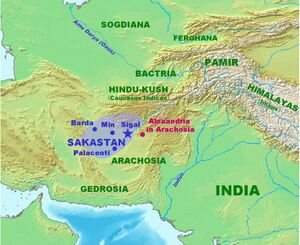Dayuan

Dayuan (Ta-yuan; Chinese: 大宛; pinyin: Dàyuān) ,literally "Great Yuan", was a country in Ferghana valley in Central Asia.
Jat clans
History
Dayuan is described in the Chinese historical works of Records of the Grand Historian and the Book of Han. It is mentioned in the accounts of the famous Chinese explorer Zhang Qian in 130 BCE and the numerous embassies that followed him into Central Asia. The country of Dayuan is generally accepted as relating to the Ferghana Valley.
These Chinese accounts describe the Dayuan as urbanized dwellers with Caucasian features, living in walled cities and having "customs identical to those of the Greco-Bactrians", a Hellenistic kingdom that was ruling Bactria at that time in today’s northern Afghanistan.
The Dayuan were probably the descendants of the Greek colonists that were settled by Alexander the Great in Ferghana in 329 BCE, and prospered within the Hellenistic realm of the Seleucids and Greco-Bactrians, until they were isolated by the migrations of the Yuezhi around 160 BCE. Alternatively, it has also been suggested that the name "Yuan" was simply a transliteration of the words “Yona”, or “Yavana”, used throughout antiquity in Asia to designate Greeks (“Ionians”), so that Dayuan (lit. “Great Yuan”) would mean "Great Ionians".
The Dayuan and the Chinese
The interaction between the Dayuan and the Chinese is historically crucial, since it represents one of the first major contacts between an urbanized Indo-European culture and the Chinese civilization, opening the way to the formation of the Silk Road that was to link the East and the West in material and cultural exchange from the 1st century BCE to the 15th century.
Zhang Qian's Report
Around 130 BCE, at the time of Zhang Qian’s embassy to Central Asia, the Dayuan were described as inhabitants of a region corresponding to the Ferghana, far to the west of the Chinese empire. “The capital of the kingdom of Dayuan is the city of Guishan (Khujand), distant from Chang'an 12,550 li (Shiji,123 calls the capital Ershi). The kingdom contains 60,000 families, comprising a population of 300,000, with 60,000 trained troops, a Viceroy, and a National Assistant Prince. The seat of the Governor General lies to the east at a distance of 4,031 li.” (Han Shu)
To their south-west were the territories of the Yuezhi, with the Greco-Bactrians further south still, beyond the Oxus. “The great Yueh-chih is situated about 2000 or 3000 li west of Dayuan; they dwell north of the river Kuei (Oxus). To the south of them there is Daxia (Bactrians), to the west, Anxis (Parthians); to the north Kangju (Sogdians).” (Shiji, 123.5b)
The Shiji then explains that the Yuezhi originally inhabited the Gansu corridor, before they were defeated by the Xiongnu under Mao-tun and later his son in 176 BCE, forcing them to go beyond the territory of the Dayuan and resettle in the West by the banks of the Oxus, between the territory of the Dayuan and Bactria to the south.
Urbanized city-dwellers The customs of the Dayuan are said by Zhang Qian to be identical to those of the Bactrians in the south, who actually formed the Greco-Bactrian Kingdom at that time.

